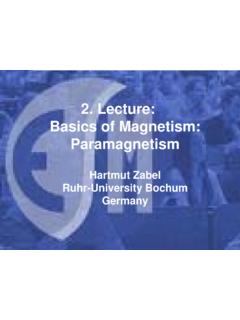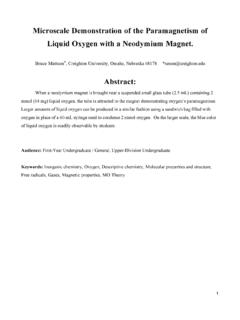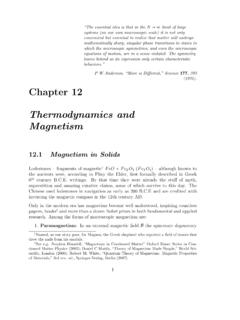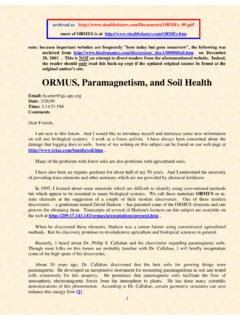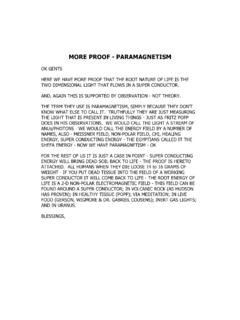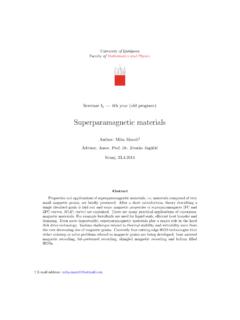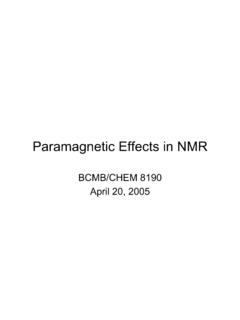Transcription of Thermal and Statistical Physics
1 Chapter 5 Magnetic Systemsc 2009 by Harvey Gould and Jan Tobochnik13 August 2009We apply the general formalism of Statistical mechanics developed in Chapter4to the Ising model,a model for which the interactions between the magnetic moments are important. We will findthat these interactions lead to a wide range of interesting phenomena, including the existenceof phase transitions. Computer simulations will be used extensively and a simple, but powerfulapproximation method known as mean-field theory will be ParamagnetismThe most familiar magnetic system in our everyday experience is probably the magnet on yourrefrigerator door.
2 This magnet likely consists of iron ionslocalized on sites of a lattice withconduction electrons that are free to move throughout the crystal. The iron ions each have amagnetic moment and due to a complicated interaction with each other and with the conductionelectrons, they tend to line up with each other. At sufficiently low temperatures, the moments canbe aligned by an external magnetic field and produce a net magnetic moment or magnetizationwhich remains even if the magnetic field is removed. Materials that retain a non-zero magnetizationin zero magnetic field are calledferromagnetic.
3 At high enough temperatures there is enough energyto destroy the magnetization, and the iron is said to be in theparamagneticphase. One of the keygoals of this chapter is to understand the transition between the ferromagnetic and the simplest model of magnetism the magnetic moment can bein one of two states asdiscussed in The next level of complexity is to introduce an interactionbetweenneighboring magnetic moments. A model that includes such aninteraction is discussed in 5. MAGNETIC Noninteracting Magnetic MomentsWe first review the behavior of a system of noninteracting magnetic moments with spin 1/2 inequilibrium with a heat bath at temperatureT.
4 We discussed this system in the microcanonical energy of interaction of a magnetic moment in a magnetic fieldBis given byE= B= zB,( )where zis the component of the magnetic moment in the direction of the magnetic the magnetic moment has spin 1/2, it has two possibleorientations. We write z=s ,wheres= 1. The association of the magnetic moment of a particle with its spin is an intrinsicquantum mechanical effect (see ). We will refer to the magnetic moment or the spinof a particle would we like to know about the properties of a system of noninteracting spins?
5 In theabsence of an external magnetic field, there is little of interest. The spins point randomly up ordown because there is no preferred direction, and the mean internal energy is zero. In contrast, inthe presence of an external magnetic field, the net magnetic moment and the energy of the systemare nonzero. In the following we will calculate their mean values as a function of the externalmagnetic fieldBand the assume that the spins are fixed on a lattice so that they aredistinguishableeven thoughthe spins are intrinsically quantum mechanical.
6 Hence the only quantum mechanical propertyof the system is that the spins are restricted to two values. As we will learn, the usual choicefor determining the Thermal properties of systems defined ona lattice is the canonical each spin is independent of the others and distinguishable, we can find the partitionfunction for one spin,Z1, and use the relationZN=ZN1to obtainZN, the partition function forNspins. (We reached a similar conclusion in ) We can derive this relation betweenZ1andZNby writing the energy of theNspins asE= B Ni=1siand expressing the partitionfunctionZNfor theN-spin system asZN= s1= 1 s2= sN= 1e B Ni=1si( )= s1= 1 s2= sN= 1e Bs1e BsN( )= s1= 1e Bs1 s2= 1e sN= 1e BsN( )=[ s1= 1e Bs1]N=ZN1.
7 ( )To findZ1we writeZ1= s= 1e Bs=e B( 1)+e B(+1)= 2 cosh B.( )Hence, the partition function forNspins isZN= (2 cosh B)N.( )CHAPTER 5. MAGNETIC SYSTEMS233We now use the canonical ensemble formalism that we developed in find thethermodynamic properties of the system for a givenTandB. The free energy is given byF= kTlnZN= NkTlnZ1= NkTln(2 cosh B).( )The mean energyEisE= lnZN = ( F) = N Btanh B.( )From ( ) we see thatE 0 asT ( 0). In the following we will frequently omit themean value notation when it is clear from the context that an average is of the results of two ensembles(a) Compare the result ( ) for the mean energyE(T) of a system of noninteracting spins inthe canonical ensemble to the result that you found in (E) using themicrocanonical ensemble.
8 (b) Why is it much easier to treat a system of noninteracting spins in the canonical ensemble?(c) What is the probabilitypthat a spin is parallel to the magnetic fieldBgiven that the systemis in equilibrium with a heat bath at temperatureT? Compare your result to the result in( ) using the microcanonical ensemble.(d) What is the relation of the results that we have found for asystem of noninteracting spins tothe results obtained in heat capacityCis a measure of the change of the temperature due to the addition ofenergy at constant magnetic field.
9 The heat capacity at constant magnetic field can be expressedasC=( E T)B= k 2 E .( )(We will writeCrather thanCB.) From ( ) and ( ) we find that the heat capacity of a systemofNnoninteracting spins is given byC=kN( B)2sech2 B.( )Note that the heat capacity is always positive, goes to zero at highT, and goes to zero asT 0,consistent with the third law of and Susceptibility. Two other macroscopic quantities of interest for mag-netic systems are the mean magnetizationM(in thezdirection) given byM= N i=1si,( )and the isothermal susceptibility , which is defined as =( M B)T.
10 ( )CHAPTER 5. MAGNETIC SYSTEMS234 The susceptibility is a measure of the change of the magnetization due to the change in theexternal magnetic field and is another example of a response will frequently omit the factor of in ( ) so thatMbecomes the number of spinspointing in a given direction minus the number pointing in the opposite direction. Often it is moreconvenient to work with the mean magnetization per spinm, an intensive variable, which is definedasm=1NM.( )As for the discussion of the heat capacity and the specific heat, the meaning ofMandmwill beclear from the can expressMand in terms of derivatives of lnZby noting that the total energy canbe expressed asE=E0 MB,( )whereE0is the energy of interaction of the spins with each other (theenergy of the system whenB= 0) and MBis the energy of interaction of the spins with the external magnetic field.
